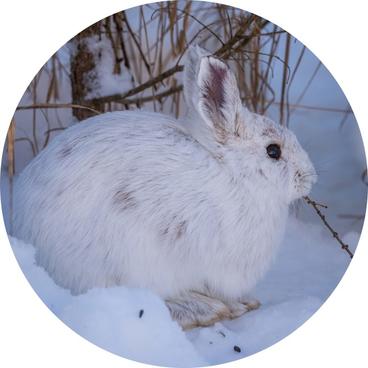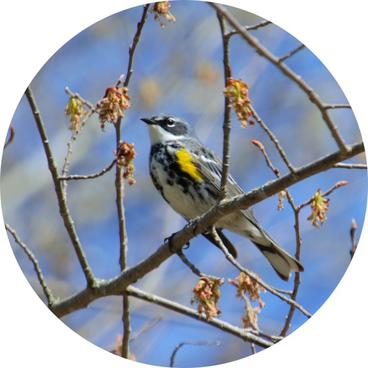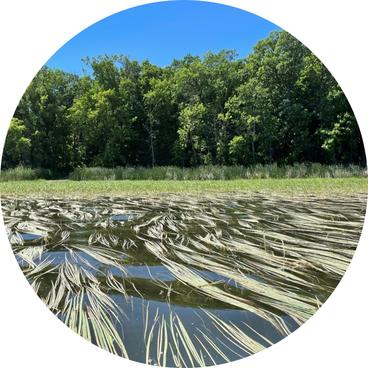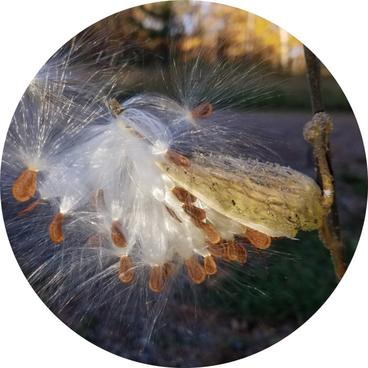What's happening outdoors from one month to the next?
In your memories of Minnesota seasons, what are plants and animals doing? Some possible answers to this question are below. Let these calendars guide your looking and listening in nature.
Keep in mind that timing in nature is essential but not uniform across Minnesota, nor constant from year to year. The more you observe, the more you are likely to notice differences between the calendar estimates below and your own real-world observations. Use the calendars as a guidepost, while also trusting your own senses and interpretations.

Snowshoe hare with white winter coat
December 29, 2021, St. Louis County Minnesota
Photo © Steve, some rights reserved (CC-BY-NC)
iNaturalist observation
December
- Winter birds active
- Migratory winter birds on this website: American tree sparrow, dark-eyed junco, and pine siskin
- Non-migratory winter bird on this website: northern cardinal
- Lakes freeze up
- Many animals hibernate, including the American black bear
- Great horned owls calling and setting up territories
- January
- Snowshoe hares in their white coat
- First northern cardinal sings "What cheer, cheer, cheer!"
- Downy woodpeckers drumming
- Wild turkeys begin gobbling
- Raccoon and skunk tracks in the snow
- Great horned owls lay eggs
- February
- Get ready to tap maple trees for syrup
- House finches active
- First active chipmunks
- Squirrels mating
- Horned larks return

Yellow-rumped warbler in a spring tree
May 5, 2019, Roseau County, Minnesota
Photo © earl woolsey, some rights reserved (CC-BY-NC-SA)
iNaturalist observation
March
- Maple sap flowing
- Rhubarb emerging
- First migrating robins, eastern bluebirds, song sparrows, and red-winged blackbirds return
- Observers near water can watch for the return of pied-billed grebes, wood ducks, and great blue herons
- Sandhill cranes returning
- Great horned owls feeding young
- Shipping season begins on the Mississippi River
- Wood frogs and boreal chorus frogs calling
April
- Listen to the Season Watch podcast (April 2023 episode, 45 minutes, host Sarah Mitchell) for phenogy ideas
- Oaks, elms, aspens and tamaracks are breaking bud
- For a full list of trees and shrubs on this website, open the "Woody plants" tab on this page
- Chipmunks are active
- Forsythia, dandelions, Canada white violets, and pasqueflowers blooming
- Watch the skies for chimney swifts and turkey vultures
- Be aware of ticks and mosquitoes
- Mourning cloak butterflies are active and seeking food
- Eastern bluebirds build nests
- Spring peepers, wood frogs, and boreal chorus frogs calling
- Time to plant lettuce and peas
- Ice out = loons in and painted turtles sunning
May
- Listen to the Season Watch podcast (May 2023 episode, 54 minutes, hosted by Sarah Mitchell) for phenology ideas
- First monarch arrives and Canadian tiger swallowtails emerge from their chrysalises
- American toads trilling
- Woodland wildflowers blooming
- Examples on this website: Canada white violet, red columbine, Virginia bluebells, and Virginia strawberry
- Lilacs, daffodils, and greater yellow lady's slippers are blooming
- Ruby-throated hummingbirds and nighthawks return
- Warblers migrating north

Wild rice leaves on the water's surface
June 15, 2021, Todd County, Minnesota
Photo © D.Perleberg, some rights reserved (CC-BY-NC-ND)
iNaturalist observation
June
- Cottonwood trees shed seeds
- Peonies, wild prairie roses, prairie smoke, raspberries and milkweed bloom
- Songbirds sing on territories
- Examples on this website: American robin, eastern bluebird, northern cardinal, red-winged blackbird, rose-breasted grosbeak, and song sparrow
- Young loons swim with parents
- Monarch caterpillars on milkweed
- Ripe strawberries
July
- Wild bergamot, purple coneflowers, goldenrod, daylilies and butterfly weed in bloom
- Basswood in bloom
- Second brood hatches for eastern bluebirds
- First new potatoes, zucchini and sweet corn
- Monarch butterflies emerge
August
- Lots of ragweed pollen
- Wild rice in bloom
- Goldenrod in bloom
- Ruby-throated hummingbirds active
- Warblers migrate south
- Blueberries and chokecherries ripen
- Common nighthawks fly south

Common milkweed shedding seeds
October 3, 2020, Beltrami County, Minnesota
Photo © Janet Nelson, some rights reserved (CC-BY-NC-ND)
iNaturalist observation
September
- Black ash and aspen trees have colored leaves
- For a list of trees and shrubs on this website, open the "Woody plants" tab on this page
- Ruby-throated hummingbirds head south
- Monarchs and common green darner dragonflies migrate south
- Honeycrisp apples ripe
- First frost
- Dark-eyed juncos arrive
October
- Many birds migrating south
- Muskrats building winter lodges
- Peak fall color (red maple and tamarack, for example)
- Soybean and sugar beet harvest
- Lakes turn over
November
- Common milkweed sheds seeds
- Last dandelion blooms
- Pine siskins arrive
- Tundra swans migrating
- Weasels and snowshoe hares turning white for winter
- Last barge traffic on the Mississippi River
Dakota moons
"Traditionally, the Dakota used the moon to determine the passing of time. A name was given to the moon each month to symbolize significant events that were important to survival and food gathering."
These 1-page phenology calendars list a handful of changes to watch for in select Minnesota counties:
- Carlton County - download PDF
- Hennepin County - download PDF
- Hubbard County - download PDF
- Itasca County - download PDF
- Marshall County - download PDF
- Ramsey County - download PDF
- Sherburne County - download PDF
- Washington County - download PDF
Information on these calendars is based on summaries of historical records (i.e., actual observational datasets).
